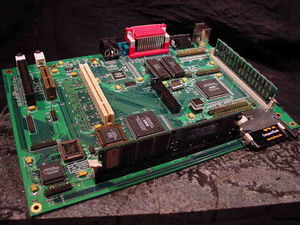Difference between revisions of "C-ONE"
| Line 1: | Line 1: | ||
[[Image:Cone.jpg|thumb|C-One mainboard]] | [[Image:Cone.jpg|thumb|C-One mainboard]] | ||
| − | The '''C-One''' ("Commodore-One", later "Computer-One") is a FPGA based reconfigurable computer, which is able to run several 8bit machines from the 80ies. Each computer has to be realised with a special so-call "core", which can be loaded into the FPGA chip. First the C-One should become mainly a modern and powerful C64 clone. But its original main developer Jeri Ellsworth was neither able to create a full running C64 core nor to develop a startup system for the core selection | + | The '''C-One''' ("Commodore-One", later "Computer-One") is a FPGA based reconfigurable computer, which is able to run several 8bit machines from the 80ies. Each computer has to be realised with a special so-call "core", which can be loaded into the FPGA chip. First the C-One should become mainly a modern and powerful C64 clone. But its original main developer Jeri Ellsworth was neither able to create a full running C64 core nor to develop a startup system for the core selection. |
| − | + | So the whole project ran into troubles before [[TobiFlex]] joined the C-ONE team and created the first complete core, the "Amstrad CPC 464 core". He also developed the C-One startup system, which is Amstrad based. Later he released the "TurboCPC core", which is nearly 100% compatible and can also run in 12MHz (later 24MHz) mode. This core is also used in the [[CPC TREX]]. | |
As there was no full working Commodore 64 core available for a very long time, but people could already use the very powerful and stable [[TobiFlex]] CPC cores, the C-One was often called "CPC-One" instead of "Commodore-One" by the scene. Several Commodore users lost their interest in the C-One, when its original creator Jery Elsworth surprisingly left the C-One team for a while and released a more or less competitive production called the "DTV-64", which was much cheaper than the C-One. | As there was no full working Commodore 64 core available for a very long time, but people could already use the very powerful and stable [[TobiFlex]] CPC cores, the C-One was often called "CPC-One" instead of "Commodore-One" by the scene. Several Commodore users lost their interest in the C-One, when its original creator Jery Elsworth surprisingly left the C-One team for a while and released a more or less competitive production called the "DTV-64", which was much cheaper than the C-One. | ||
Revision as of 13:24, 10 August 2006
The C-One ("Commodore-One", later "Computer-One") is a FPGA based reconfigurable computer, which is able to run several 8bit machines from the 80ies. Each computer has to be realised with a special so-call "core", which can be loaded into the FPGA chip. First the C-One should become mainly a modern and powerful C64 clone. But its original main developer Jeri Ellsworth was neither able to create a full running C64 core nor to develop a startup system for the core selection.
So the whole project ran into troubles before TobiFlex joined the C-ONE team and created the first complete core, the "Amstrad CPC 464 core". He also developed the C-One startup system, which is Amstrad based. Later he released the "TurboCPC core", which is nearly 100% compatible and can also run in 12MHz (later 24MHz) mode. This core is also used in the CPC TREX.
As there was no full working Commodore 64 core available for a very long time, but people could already use the very powerful and stable TobiFlex CPC cores, the C-One was often called "CPC-One" instead of "Commodore-One" by the scene. Several Commodore users lost their interest in the C-One, when its original creator Jery Elsworth surprisingly left the C-One team for a while and released a more or less competitive production called the "DTV-64", which was much cheaper than the C-One.
